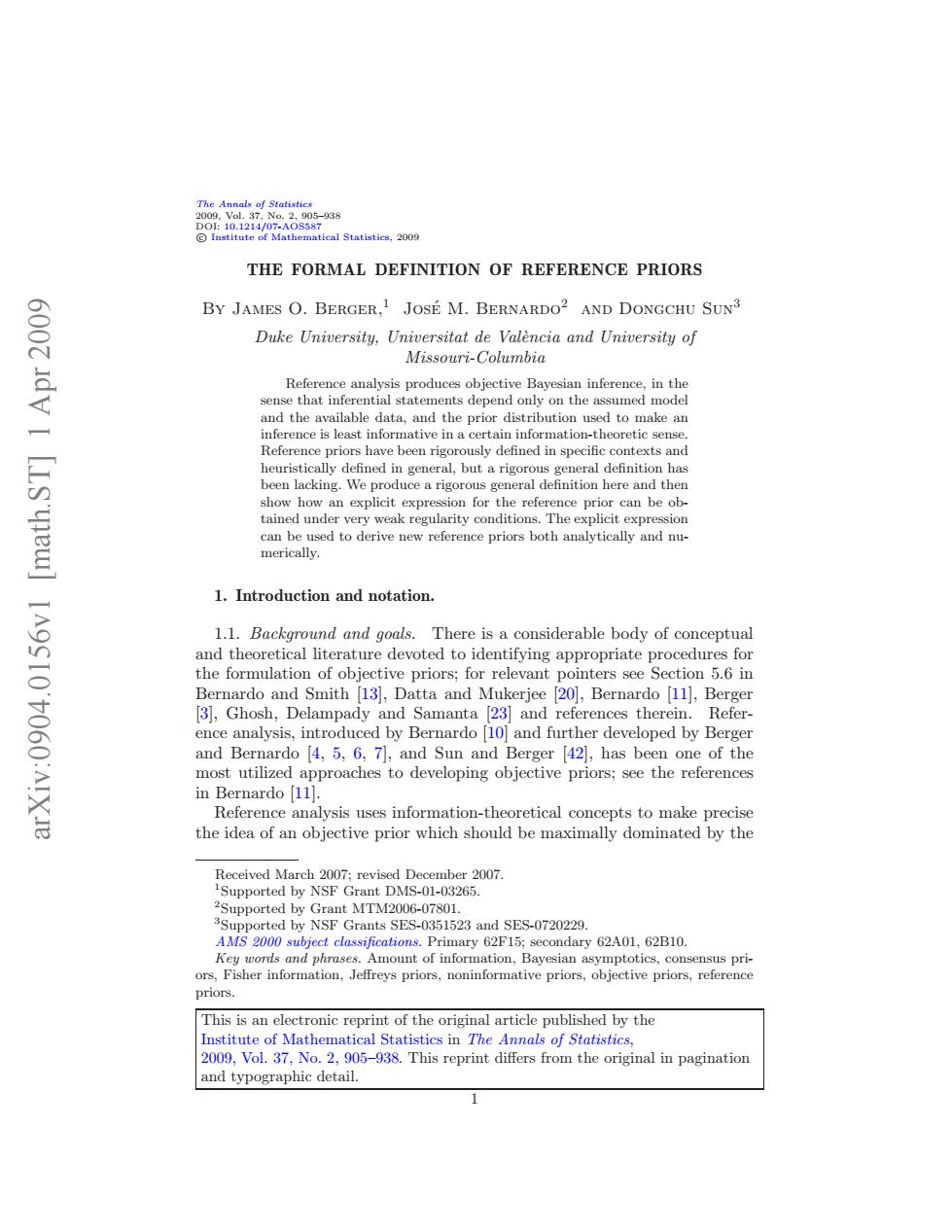正在加载图片...

The Annals of Statistics 2009,Vol.37,No.2.905-938 D0:10.1214/07-A0S587 Institute of Mathematical Statistics,2009 THE FORMAL DEFINITION OF REFERENCE PRIORS BY JAMES O.BERGER.1 JOSE M.BERNARDO2 AND DONGCHU SUN3 Duke University,Universitat de Valencia and University of Missouri-Columbia Reference analysis produces objective Bayesian inference,in the sense that inferential statements depend only on the assumed model and the available data,and the prior distribution used to make an inference is least informative in a certain information-theoretic sense. Reference priors have been rigorously defined in specific contexts and heuristically defined in general,but a rigorous general definition has been lacking.We produce a rigorous general definition here and then show how an explicit expression for the reference prior can be ob- tained under very weak regularity conditions.The explicit expression can be used to derive new reference priors both analytically and nu- merically. 1.Introduction and notation. IA9S10'060:A!XIe 1.1.Background and goals.There is a considerable body of conceptual and theoretical literature devoted to identifying appropriate procedures for the formulation of objective priors;for relevant pointers see Section 5.6 in Bernardo and Smith [13],Datta and Mukerjee [20],Bernardo [11],Berger [3],Ghosh,Delampady and Samanta 23]and references therein.Refer- ence analysis,introduced by Bernardo [10]and further developed by Berger and Bernardo [4,5,6,7],and Sun and Berger [42],has been one of the most utilized approaches to developing objective priors;see the references in Bernardo [11]. Reference analysis uses information-theoretical concepts to make precise the idea of an objective prior which should be maximally dominated by the Received March 2007:revised December 2007. Supported by NSF Grant DMS-01-03265. 2Supported by Grant MTM2006-07801. 3Supported by NSF Grants SES-0351523 and SES-0720229. AMS 2000 subject classifications.Primary 62F15;secondary 62A01,62B10. Key words and phrases.Amount of information,Bayesian asymptotics,consensus pri- ors,Fisher information,Jeffreys priors,noninformative priors,objective priors,reference priors. This is an electronic reprint of the original article published by the Institute of Mathematical Statistics in The Annals of Statistics, 2009,Vol.37,No.2,905-938.This reprint differs from the original in pagination and typographic detail.arXiv:0904.0156v1 [math.ST] 1 Apr 2009 The Annals of Statistics 2009, Vol. 37, No. 2, 905–938 DOI: 10.1214/07-AOS587 c Institute of Mathematical Statistics, 2009 THE FORMAL DEFINITION OF REFERENCE PRIORS By James O. Berger,1 Jos´e M. Bernardo2 and Dongchu Sun3 Duke University, Universitat de Val`encia and University of Missouri-Columbia Reference analysis produces objective Bayesian inference, in the sense that inferential statements depend only on the assumed model and the available data, and the prior distribution used to make an inference is least informative in a certain information-theoretic sense. Reference priors have been rigorously defined in specific contexts and heuristically defined in general, but a rigorous general definition has been lacking. We produce a rigorous general definition here and then show how an explicit expression for the reference prior can be obtained under very weak regularity conditions. The explicit expression can be used to derive new reference priors both analytically and numerically. 1. Introduction and notation. 1.1. Background and goals. There is a considerable body of conceptual and theoretical literature devoted to identifying appropriate procedures for the formulation of objective priors; for relevant pointers see Section 5.6 in Bernardo and Smith [13], Datta and Mukerjee [20], Bernardo [11], Berger [3], Ghosh, Delampady and Samanta [23] and references therein. Reference analysis, introduced by Bernardo [10] and further developed by Berger and Bernardo [4, 5, 6, 7], and Sun and Berger [42], has been one of the most utilized approaches to developing objective priors; see the references in Bernardo [11]. Reference analysis uses information-theoretical concepts to make precise the idea of an objective prior which should be maximally dominated by the Received March 2007; revised December 2007. 1Supported by NSF Grant DMS-01-03265. 2 Supported by Grant MTM2006-07801. 3Supported by NSF Grants SES-0351523 and SES-0720229. AMS 2000 subject classifications. Primary 62F15; secondary 62A01, 62B10. Key words and phrases. Amount of information, Bayesian asymptotics, consensus priors, Fisher information, Jeffreys priors, noninformative priors, objective priors, reference priors. This is an electronic reprint of the original article published by the Institute of Mathematical Statistics in The Annals of Statistics, 2009, Vol. 37, No. 2, 905–938. This reprint differs from the original in pagination and typographic detail. 1